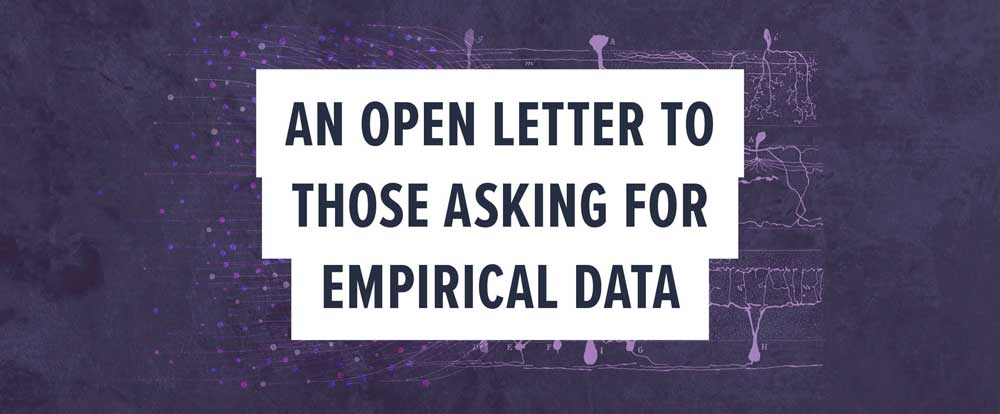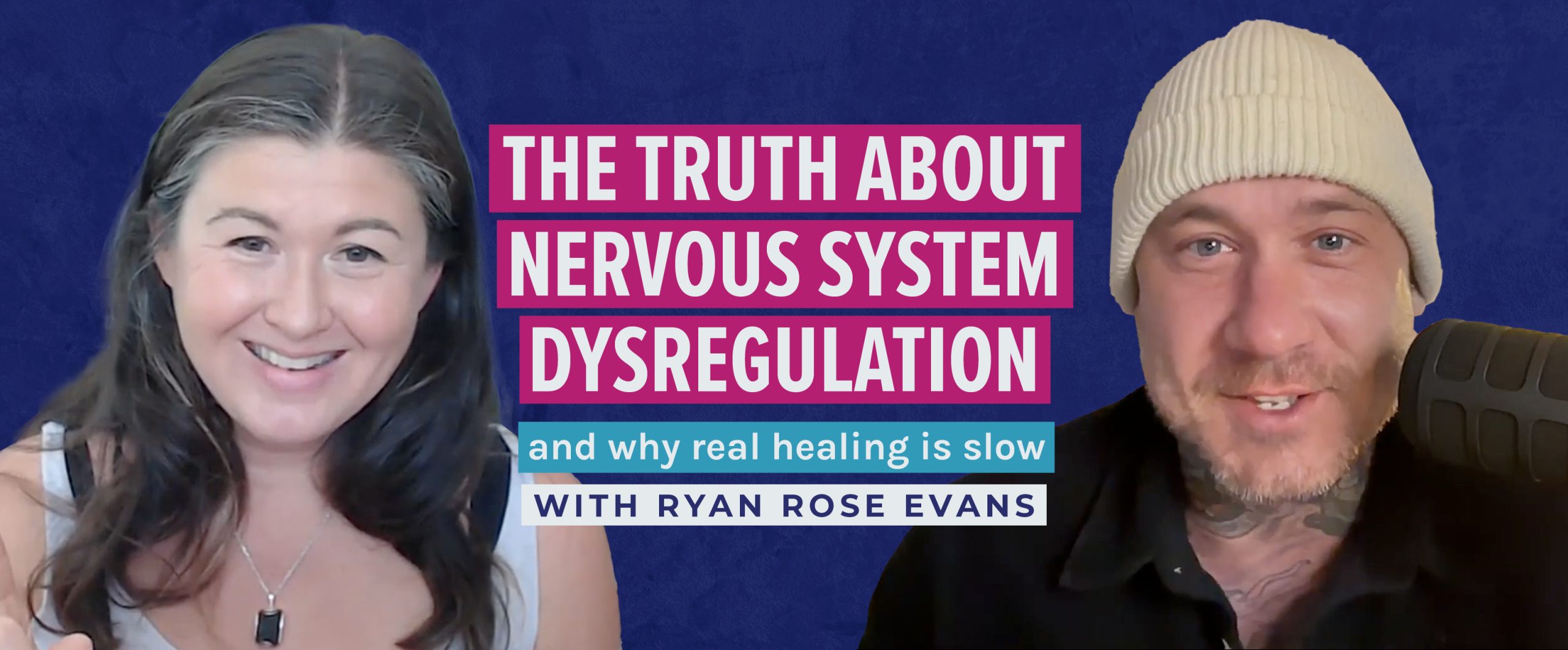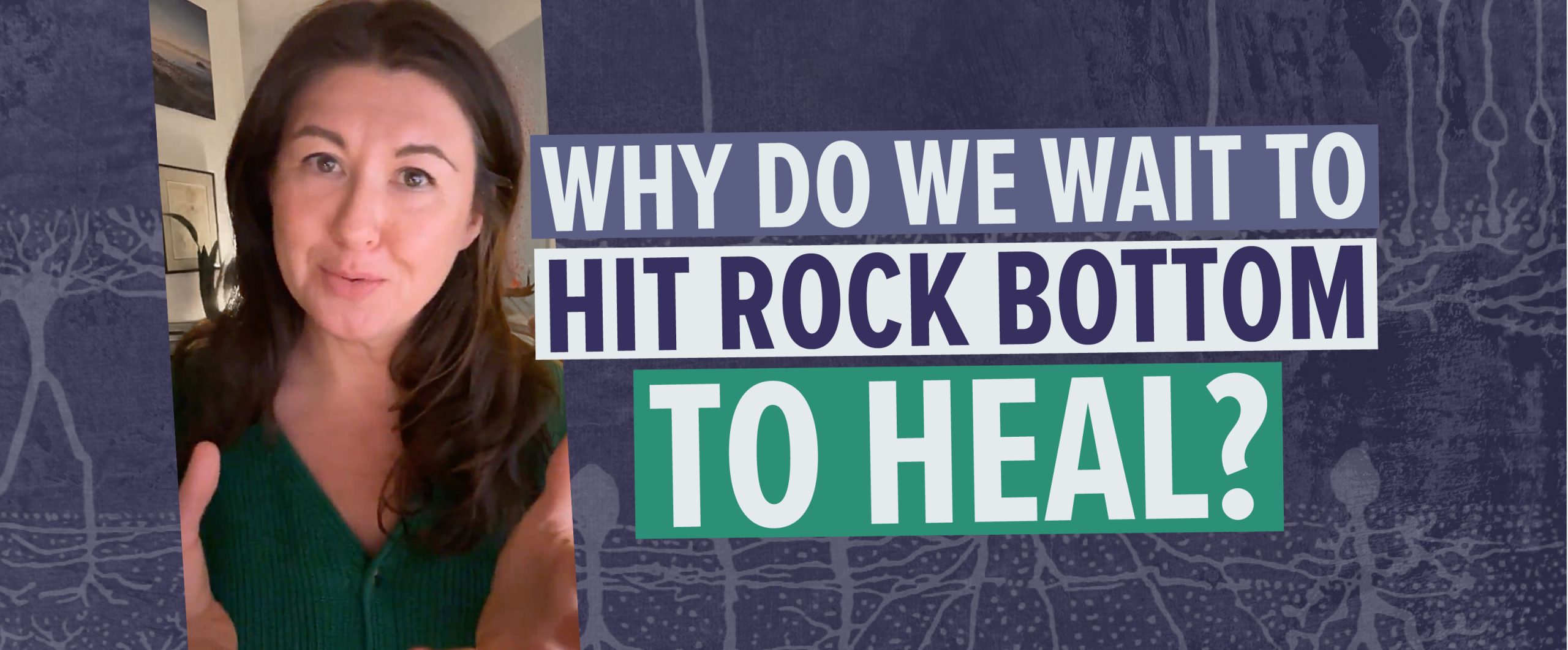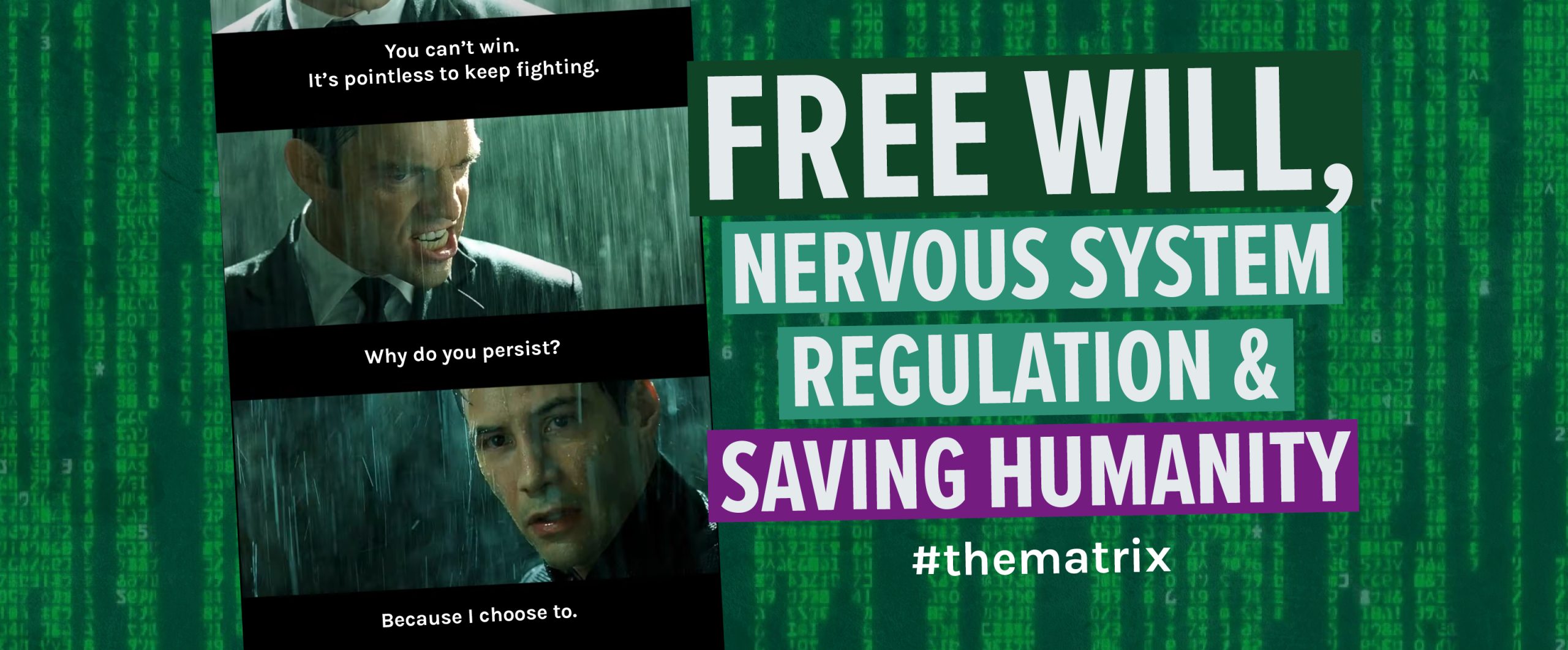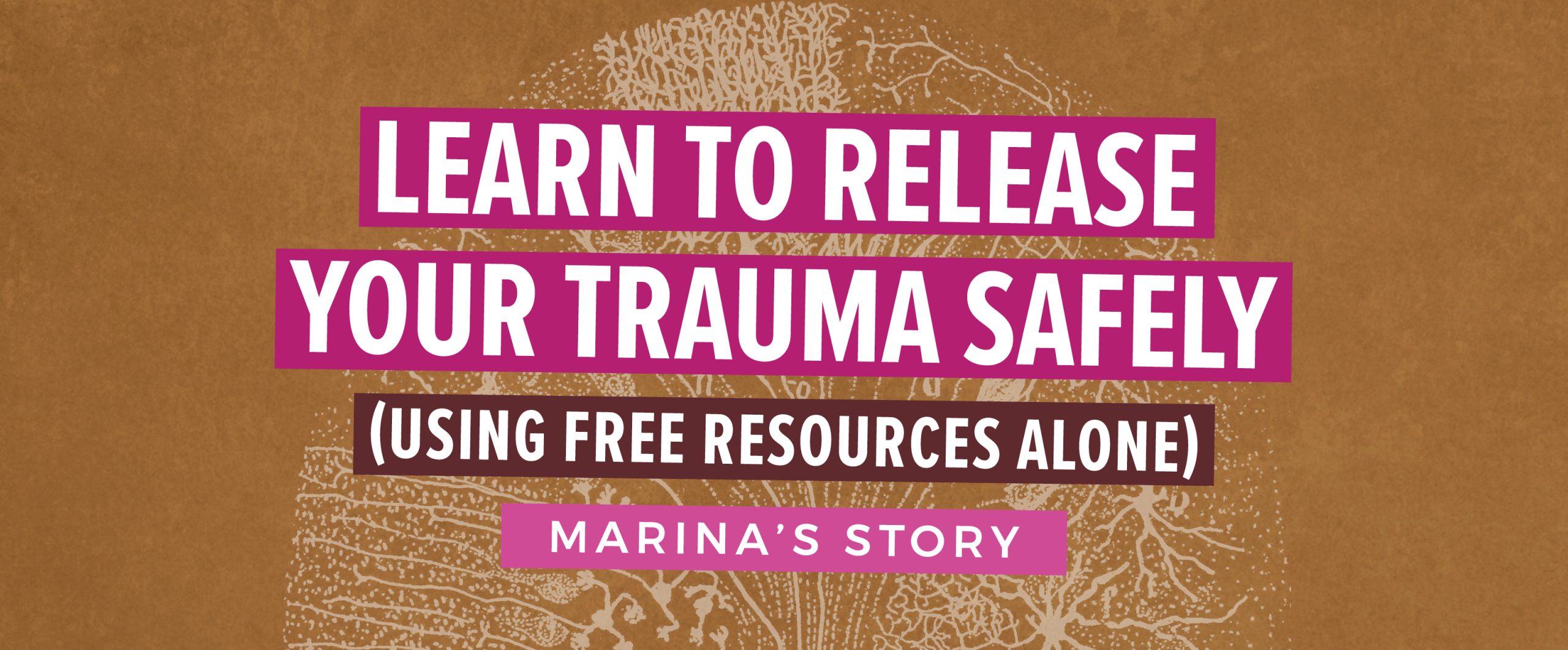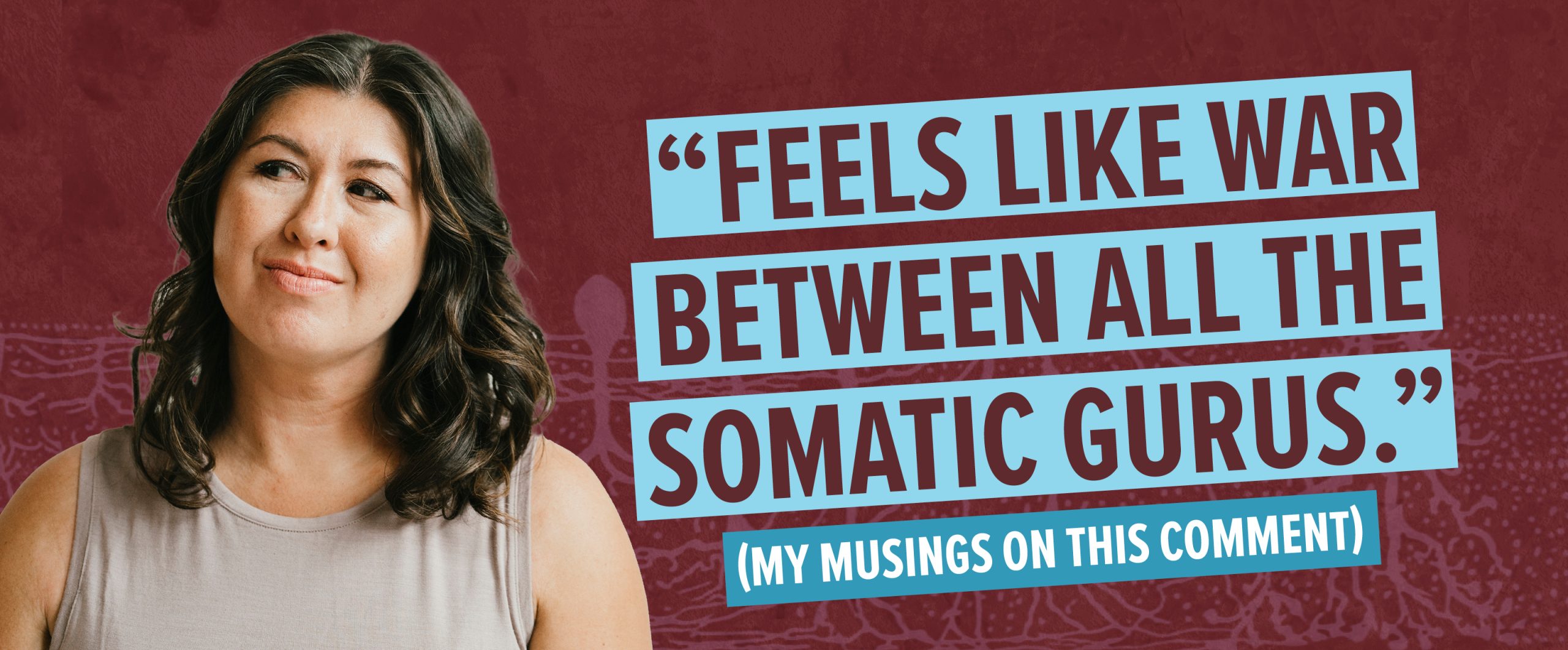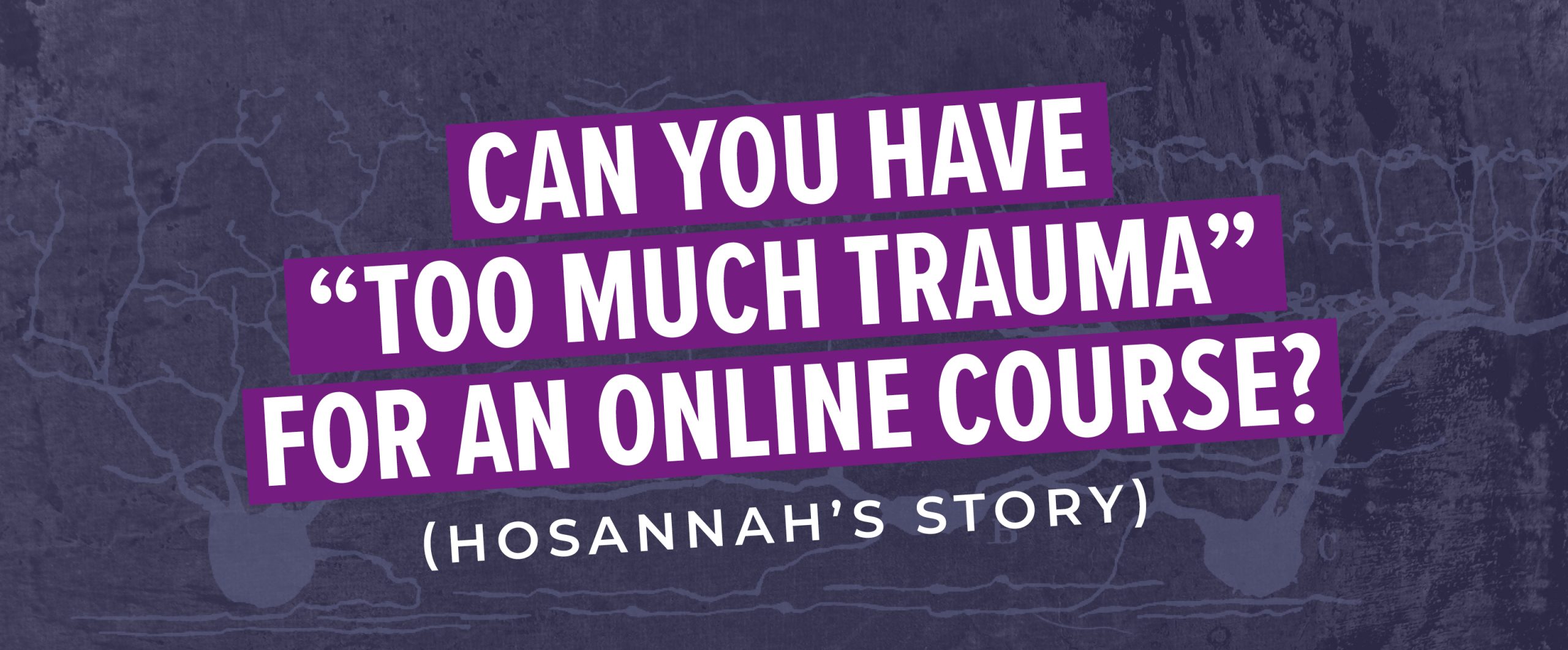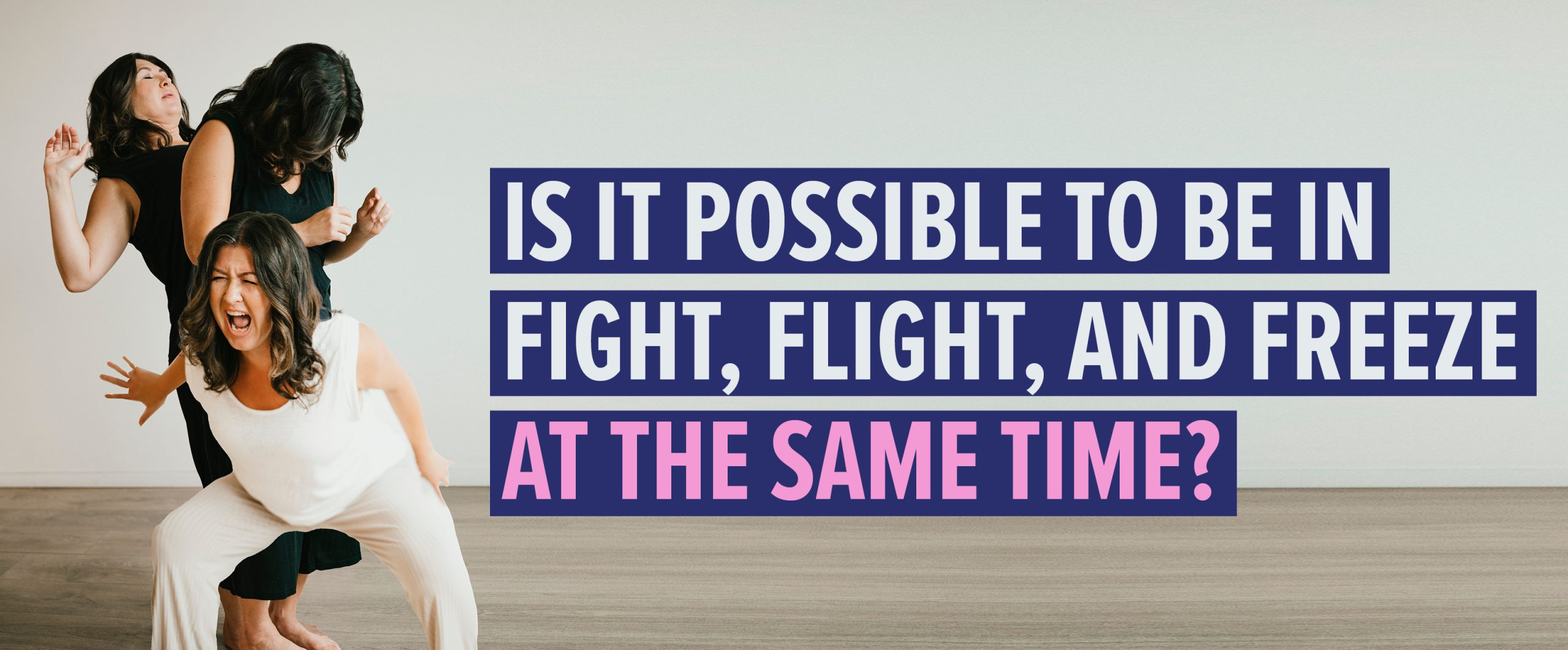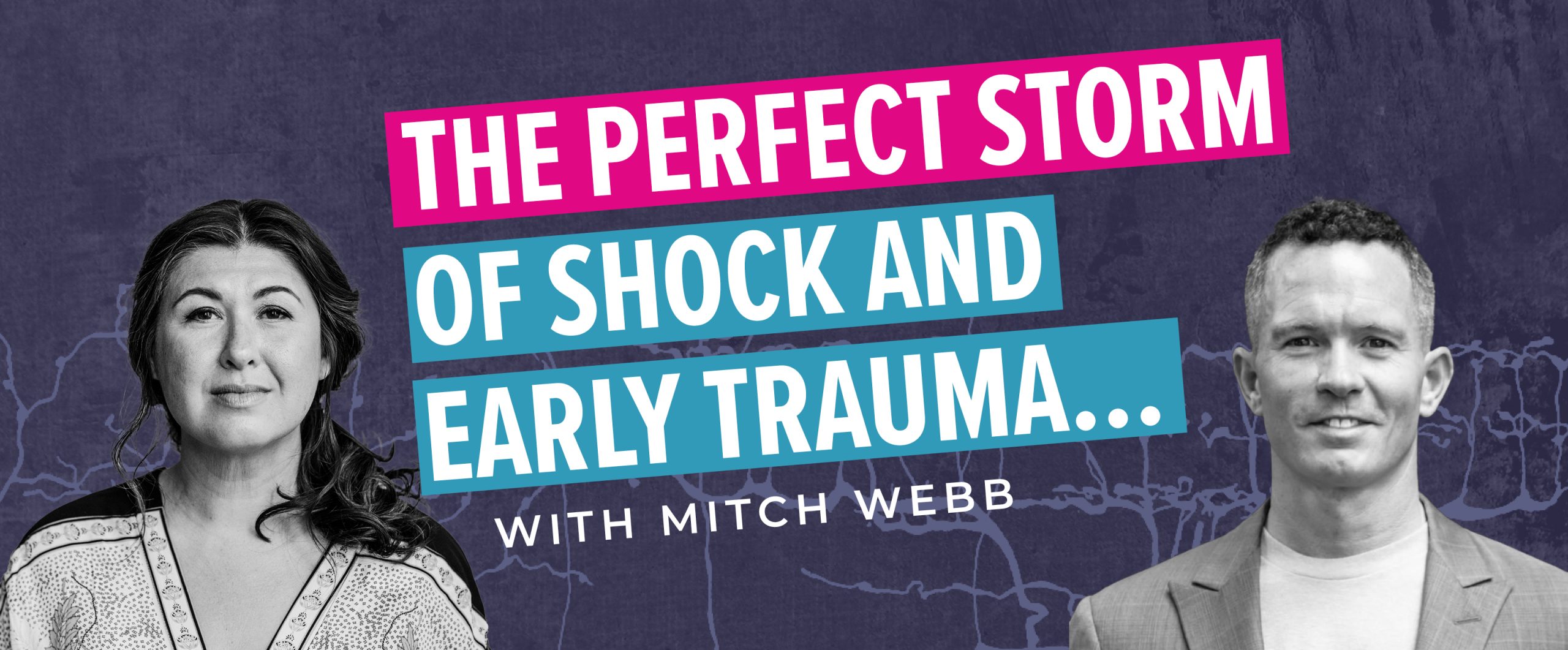THE BACKSTORY (a scientific study on SBSM):
Three years ago (in 2021), we partnered with Mitacs, a non-profit organization that pairs industry with academia (in this case, the University of Victoria) to run a group of students through the SmartBody SmartMind™ (SBSM) curriculum as the university studied them with subjective measures pre and post (survey and assessment tools for self-worth, loneliness, interoception, pain scales, etc.).
Earlier this year (in 2024), we received the draft Press Release from Mitacs for the preliminary results of this study (yes, these things can take YEARS – more on that below!).
.
THE CONTEXT (where this ‘open letter’ idea arose from):
In the following exchange, which took place in the comments section of this vlog on Pain. As Irene happened to catch the exchange after our initial reply, she followed up personally:
.
THE COMMENT (which, though heated, raises a valid and important question):
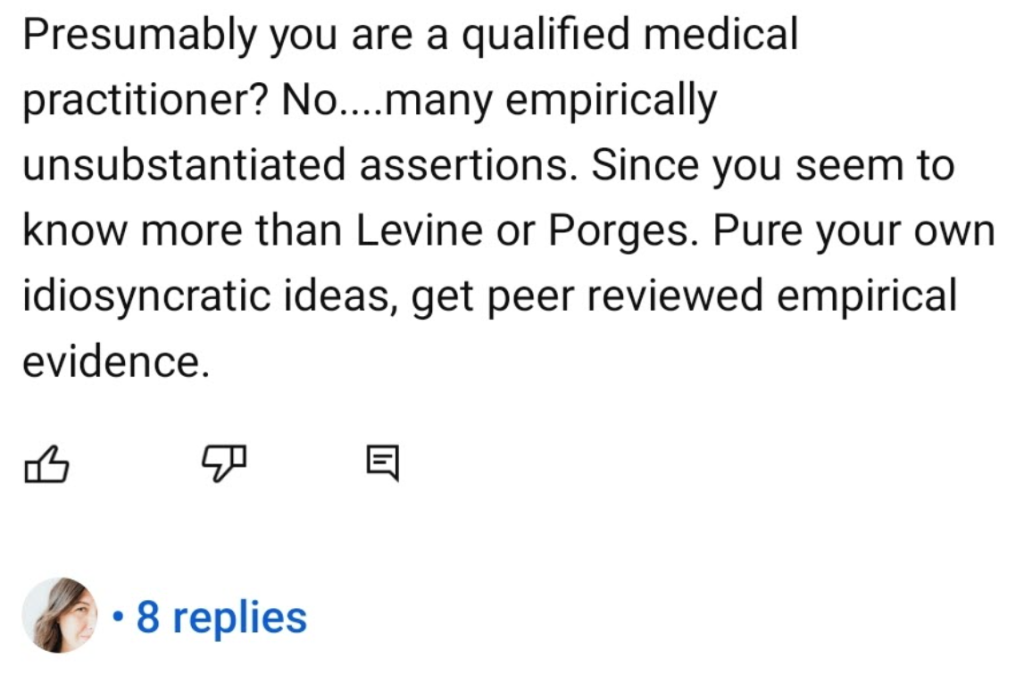
THE FIRST REPLY (which, though accurate, did not fully address the question):
Hello, Sophia with Team Lyon here. Irene is not a medical practitioner but a Master Somatic Practitioner and Nervous System Expert. You can see her credentials here: https://irenelyon.com/meet-irene/#credentials and https://irenelyon.com/bragging-rights/
I hope this helps answer your question.
.
THE RESPONSE
@IreneLyon This proves nothing. What is needed is clear, substantiated evidence of her claims of the so-called treatment that needs to be demonstrated empirically valid. There are so many asserted guru types on the internet – offering courses in this method or that – and paying up to so much gullibility and anecdotal placebo effects.
.
IRENE’S ANSWER (in which she shares an excerpt from the aforementioned Mitacs study):
I understand your point of view here and desire for more evidence-based research. Both my parents are retired small animal veterinarians and I was surrounded by various aspects of medicine, not to mentions peer-reviewed journals, my entire life, so I hope you at least read point #4 below.
1 – We are at a point in time wherein a lot of this new traumatology work (Peter Levine’s included) had not been rigorously tested via the scientific methods (see below for that changing!) and there is a good reason for this, one of which being that it is very hard to get accurate data in living systems (especially the nervous system).
This was one of the hard lessons learned while doing my masters of research in biomedical science with humans. My dissertation is linked on my site (via this link to my credentials that Sophia also shared above) if you’d like to read my conclusions.
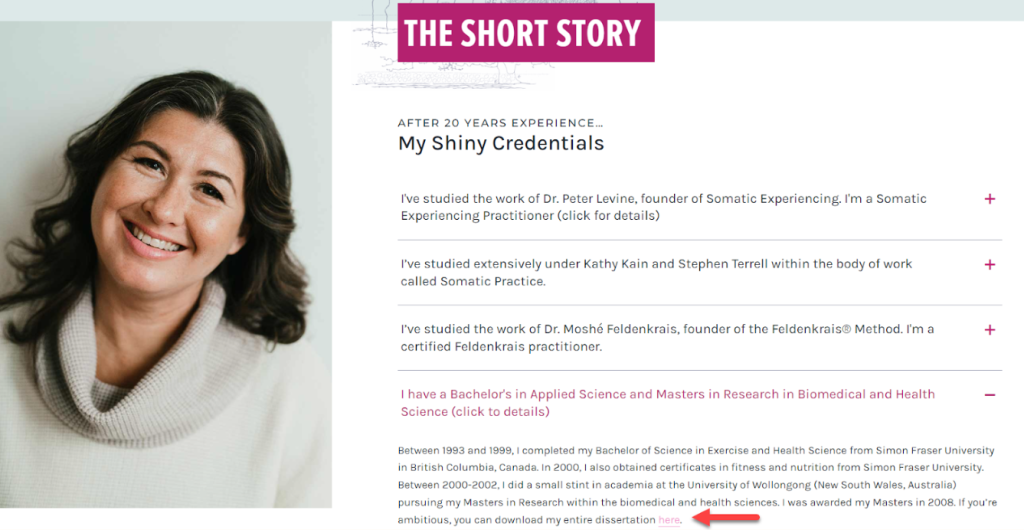
(the red arrow in the image above indicates where to find Irene’s dissertation via the link above)
In essence, what I found was that the most significant life changes in health were anecdotal shares of improvements in functional daily living, things that could not be tested objectively. It was via listening to their stories where I “saw” the “data.”
2 – Regarding my specific online work: There is qualitative evidence via our 100+ video interviews, written testimonies, and shares via our alumni panels. Our most recent alumni panels are worth listening to as they showcase case study upon case study of people making real gains. Here is one of them: https://youtu.be/qlOXcdwRS9g?si=O0Zw9otYYIaEFY2T
We have story upon story of our students healing ailments that medical doctors said would never shift out of and all they could do was manage and cope.
*You reference Peter Levine above and he would also have countless stories of such healing with his clients over his 40+ years career.
3 – Medical science and research (typically) starts with a thesis and then testing it via people on the ground, taking observations, sharing data, and then seeing if it can be repeated.
Surgical or medical innovation happens this way too – a doctor might need to try something ‘on the fly’ during internal surgery and they realize it works better than what they were taught in medical school, so they talk about it, they share it with their peers and elders, and eventually, it become ‘textbook.’
This work is no different. And it takes up to 15 or more years for our textbooks to be rewritten. We are just at the start of learning how to heal with these methodologies. Give us time.
4 – Currently we have completed one (1) intervention study (using SBSM’s curriculum) that has gone through scientific investigation via the University of Victoria here in BC. Here is a portion of the Press Release that we have just received:
.
***START PRESS RELEASE***
VANCOUVER, BC, April 18, 2024
Vancouver-based wellness company Scientuitive – Fitness & Wellness Education Inc. is proud to share the emerging results from a collaboration with researchers at the University of Victoria in British Columbia, Canada, to investigate the impact of the company’s online body-mind training program, SmartBody SmartMind™ as devised by Irene Lyon, experienced somatic educator and facilitator. The information provided is preliminary, as it is currently under scientific review for publication and will be available in its final form in coming months.
Mental and physical illness present a significant burden to the individual, as well as society. While scientists and clinical practitioners have understood the mind-body connection for many years, we still see discrete disorders are still often treated in isolation, rather than looking at the whole person, using a holistic healing approach. Prevailing approaches grounded in mental health often focus on changing how a person thinks and acts through approaches such as cognitive-behaviour therapy.
While these approaches work for many people, they do not work for everyone, as they are limited to “top-down” approaches to health and well-being. Interoception is a construct that refers to our ability to notice and connect to the sensations within our body. Research demonstrates that it connects to both physical and mental health, as well as certain aspects of cognitive function. Despite these findings in the research, “bottom-up” approaches using interoceptive awareness seem to be under-utilized in many mainstream mental health approaches. This is particularly relevant for people who may have been exposed to different types of trauma, including childhood adversity, as trauma can negatively impact one’s ability to connect with, and feel safe in, one’s own body.
SmartBody SmartMind™ (SBSM) is a 12-week online program created by nervous system expert and somatic practitioner Irene Lyon, MSc. This program runs twice a year and teaches people how to become their own medicine. Its focus is to restore nervous system regulation through polyvagal-informed education, practical neurosensory exercises, and interactive support.
SBSM worked with a team of researchers at the University of Victoria to evaluate the impact of their program on a diverse group of participants with self-reported physical and mental health concerns. Specifically, they worked with members of the SMARTLab in the Department of Psychology, led by Dr. Colette Smart, Associate Professor of Psychology. The lead researcher on the team was Dr. Jordan Ali, Mitacs Accelerate Postdoctoral Fellow, who worked to design a program of research to evaluate how participating in SBSM, an interoceptive (i.e., somatic) training program could impact self-report as well as cognitive test performance. The research team recruited a group of participants who were signed up to take SBSM and agreed to be followed in a research capacity. Rather than having a control group against which to compare SBSM, participants acted as their own “control” in the study. Participants were tested 12 weeks before the training began, where they were simply living their daily life. They were tested immediately before the program, and once more immediately after the 12 week program. This allowed for comparisons in the time period before the program (i.e., “baseline”) compared to the time period after (i.e., “post-program”).
The study revealed several significant findings. First, it was found that, as anticipated, the program did result in several increases in participants’ somatic or interoceptive awareness, relative to baseline. Specifically, they reported greater trust and safety in their body as well as less worrying about bodily experiences, indicating a different relationship to one’s body following the program. Compared to baseline, participants also showed greater self-compassion, as well as a trend toward improvements in relationship functioning. Participants also self-reported improvements in specific aspects of cognitive function, including their ability to focus and regulate their attention, avoid distraction, and be better organized, although these findings were based on self-report only because most participants performed well on cognitive testing at baseline.
People who had mental health challenges reported doing slightly better in terms of being less distractible, and less over-identified with their problems. By comparison, people with physical health challenges showed slightly less benefits, specifically, less of an increase in focused attention and less of a decline in over-identification with problems. Finally, a large proportion of the participants reported having adverse childhood experiences (ACEs). Those with higher ACEs seemed to benefit more from the program than those without, including a greater reduction in perceived stress, overall physical symptom severity, and reduction in trauma-related functional impairments, as well as a trend toward higher resiliency.
Upon reviewing the findings, Dr. Smart commented, “These findings are innovative and add evidence to support the value of interoceptive-focused interventions and their potential to improve people’s experiences of mental and physical health. Such interventions may be particularly beneficial for people with difficult childhoods, who struggle to connect with and ‘befriend’ their own bodies. Being able to offer programs such as SBSM in a large online platform has the potential to reach people who do not have other options for mental health support or therapy. It also allows building of community for people who may otherwise feel quite isolated in their suffering.”
Scientuitive – Fitness & Wellness Education Inc., CEO, Irene Lyon, added: “It was wonderful to get a little piece of academic research complete to showcase the power of a non-invasive and self-guided approach to trauma healing via the improvement of nervous system regulation. Working with the SmartLab team and having the financial support from Canada’s Mitacs Accelerate program has been instrumental in enabling this academic collaboration.”
About Scientuitive – Fitness & Wellness Education Inc. (https://irenelyon.com/)
Established in 2005, Scientuitive – Fitness & Wellness Education Inc. provides online and live in-person support programs to address somatic, nervous system based trauma. To date the company’s online programs and classes have reached over 19,000 people in over 90 countries.
About the University of Victoria (https://www.uvic.ca)
UVic is one of Canada’s leading research-intensive universities, offering life-changing, hands-on learning experiences to more than 21,000 students on the edge of the spectacular BC coast. As a hub of transformational research, UVic faculty, staff and students make a critical difference on issues that matter to people, places and the planet. UVic consistently publishes a higher proportion of research based on international collaborations than any other university in North America, and our community and organizational partnerships play a key role in generating vital impact, from scientific and business breakthroughs to achievements in culture and creativity.
About Mitacs (https://www.mitacs.ca/en)
Mitacs is a key link between industry and post-secondary institutions, driving collaborations at home and abroad to develop projects which solve business challenges and develop Canada’s innovation capacity. Mitacs is passionate about developing the next generation of researchers helping to fuel Canada’s knowledge-based economy.
Media inquiries
***END PRESS RELEASE***
.
My hope is to continue to work in this realm and help people. I have found I have helped more people doing this than being in a research setting confined to industry funding. When and if there is an opportunity to study our program via the scientific method and perhaps via objective biomarkers, I welcome that fully.
Irene.
.
THE FINAL RESPONSE
@IreneLyon Wow, what a detailed and informative reply and explanation. I understand the points you are making. Thanks for taking the time to write this. It’s fascinating.
.
THE CONCLUSION
In a nutshell, the study results showed some promising mental health markers, but not so much with the chronic illness, as it takes longer for those things to shift.
It is important to know that we have many testimonies from our SBSM alumni wherein they have shifted and fully healed chronic illnesses of all kinds. Those who realize this typically spend a few years working through the SBSM curriculum, and they also make this work their lifestyle.
In the end, what it showed us is how limited it is when you conduct a study in such a format with lower numbers of people. It would be great to do a retrospective study of our entire SmartBody SmartMind membership as well as something wherein we “follow” new students as they begin working with the SBSM curriculum and into the future.
Sixteen weeks is just not enough time to measure the real, long-term outcomes of this work…
More to come, in time, we hope.
Irene & Team Lyon
SBSM is Irene’s flagship, 12-week, nervous system rewire curriculum. It runs in live semesters 1-2 times twice a year, but members get lifetime access to the curriculum and can participate in the live semesters indefinitely. Learn more and get on the waitlist at smartbodysmartmind.com.

